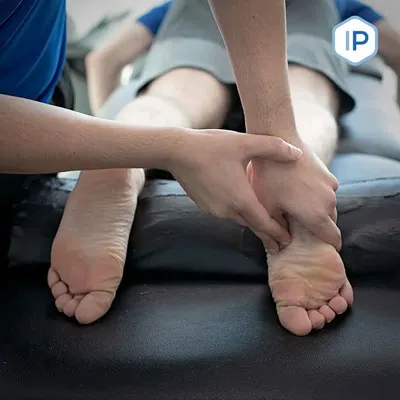Back pain while working from home is a really common issue that has been affecting people more than ever since the Covid-19 pandemic. This year’s Backcare Awareness Week (running from the 4th to the 8th October 2021) aims to help address this, and here at Indergaard Physio we wanted to make sure you had access to some best practise thinking and have some practical ideas you can use to improve your situation or pass on to others in need of this advice.
Since many people will remain doing at least some of their working week from home, this remains a vital topic to cover, even as we move forward towards more routine working practices.
This blog aims to give you some actionable tips that you can use today if you have suffered or are suffering with back pain while working from home. That being said, if you are one of those forward-thinking souls that like to stay ahead of the curve, and reduce the likelihood of this happening to you, there’s valuable information here for you too!
How do we end up with back pain while working at home?
Think about the desk setup you had at work, what did it consist of?
Now do the same for your home office space – can you spot any differences?
Our bodies get used to a certain way of doing things, and sometimes a simple change in environment can be all it takes to change the way your back responds to the working day.
Make a list (you can do this in your head) of the differences you have spotted in the working environment. Try to work out what these changes may be leading to. It’s not that these changes are intrinsically bad, but they may have happened suddenly without your back having time to adapt. Perhaps you were in an active role, and your working environment consisted of things to be lifted, distances to be walked and now you are in more of a sedentary position. Perhaps you had a fantastic desk with a really comfy chair and a desktop computer, whereas now you are balancing a laptop on a desk that is full and slightly too low and your chair is years past comfy.
Again, there is no perfect ‘ergonomic’ chair, but the changes in environment can definitely have an impact.
If there are no differences in your work environment, we now have to turn to any behaviours that may have changed since working from home. Do you remain seated for longer without changing position? Maybe you don’t get up to make a drink as frequently, or perhaps you used to walk to work and now you no longer do?
These are all subtle changes that can affect your body and perhaps lead to sensitivity of the back, with pain as a result.
Lastly for this section, we need to take account of any changes in your level of physical activity, sleep, stress and dietary components (we could include things like smoking and alcohol use here too) because these may also be involved in back pain.
For example, do you now work late into the night to get that project done since the official working hours seem to have dissolved as you work from home? Could this lead to poor sleep and increased sensitivity to pain? Very possible.
Have you increased your smoking since you don’t have to go to a designated area that is far enough away to limit the number of trips you would make?
We’re not going to go through all of the examples here, but you could think about any changes in behaviour around the following categories and consider how this could be affecting you:
You could make a list of all of these considerations using a checklist like the one you can see below.
‘Back Pain at Home Checklist’
Changes in workplace environment:
Changes in my behaviours or those around me:
Sleep:
Nutrition:
Alcohol:
Physical Activity:
Stress:
Smoking:
Obviously not all of these will apply to you, but see if you can come up with some things in each of the relevant categories because we will be using this list below to drive some of our key behaviours or actions.
What can we do about it?
Much of this will be individual to you, however we can work through some hypothetical examples together to show how we can change the way we think about what is leading to our pain and how we can improve it!
The first few have answers, the last couple are left blank to try to get you thinking strategically about all of this before applying this process to your own situation (teach a person to fish, don’t give them a fish!).
Sample List
Changes in workplace environment: My desk is quite a bit lower than the one at work and I’m stooping to reach my laptop.
You could try raising the laptop on books or alternatively find a higher table AND stack this with books to create a DIY standing desk. You could then change between sitting and standing throughout the working day.
Changes in my behaviours or those around me: I stay in one place virtually all day other than quickly grabbing some lunch (though I don’t eat much)
Set a timer for every hour, when the timer goes off, stand up, or better yet go refill your glass of water (use a small glass so it forces you to need to refill fairly frequently).
Sleep: I have been sleeping less well since working from home.
Have a rule with screens! Turn off screens and turn off from work at least two hours before you go to bed. Try some basic ‘mindfulness’ exercises or journaling to help wind-down. This journaling can be particularly effective if you make a list of the things that you will do tomorrow – this gives a sense of organisation and allows you to formalise the fact that you are leaving it until tomorrow in a planned way!
Nutrition: I have gotten into a habit of working late and then ordering takeaway food
Try to batch cook meals where possible, have 1-2 nights where you are ‘allowed’ a takeaway and try to stick to this. If this is not possible identify the ‘healthiest’ takeaway outlet in your area, but make sure you do this when you are not hungry! Then if there is a day when you just can’t face making food, you have a way to engage in damage control. This is obviously more complex if you have kids!
Alcohol: N/A In this case
Physical Activity: I feel like my level of activity has gone down, there was a gym near my work and now I don’t tend to go as I’m tired at the end of the day and the additional journey is too much at that time.
A great option is to have a couple of pieces of equipment (like a light kettlebell) near the desk, or alternatively learn some bodyweight exercises like squats that you could do a few (maybe 10-15 reps) every few hours through the day. If your back pain is severe you may want to have a chat with one of our physios first but the principle of little and often certainly helps. This way you don’t HAVE to get to the gym at the end of the day because you will have stayed more active throughout, the gym is then an option for those seeking to improve their performance.
Please note here that specific exercise recommendations would need a full assessment to be appropriate for you. Please get in touch if that sounds good to you.
Stress:I feel like I can’t ‘switch off’ from work as I’m living in my workplace! Your turn: try to think of three pieces of advice you would give to someone else who found themselves suffering with stress and low back pain while working from home.
Smoking: I feel the need to smoke more since I wake up stressed and basically stay that way until I eventually get to sleep after I stop looking at my Facebook feed at 2am Your turn: try to think of one or two pieces of advice you could give to someone in the position described above.
Now it’s time to apply all this to YOUR current situation!
How can we stop this happening in the first place?
Now this is where we take what we’ve learned above and start to think about how we might change things BEFORE we get an episode of back pain while working from home .
We can try to give ourselves the opportunity to have variable positions (sitting, standing, walking), physical activity and health enhancing strategies into our working day and built into our working environment:
- DIY standing desk
- Laptop stand or some books to raise laptop if needed
- Dual screen setup (so you can simplify your workflow transitions)
- External keyboard – this may mean you can setup the keyboard in a comfortable position
- Get an ergonomic mouse in addition to your normal mouse (helps with adding variation to your working positions but may not directly impact on your back)
- Small glass size for your water so you must take a small walk to refill from the kitchen
- Small pieces of exercise equipment placed around the desk (for example a kettlebell)
- Walk to a local park (if you have one) to take a proper lunch break (this will help you stay active and give your brain a much needed break
- Setup your office in a room that is NOT your bedroom so you have a space to go to that has no association with work
- Turn off your screens at a specific time and build wind-down time/activities into your bedtime routine
You could also consider adding some back targeted exercises to your routine, consider seeking help to plan and integrate a regular routine. We would be more than happy to help you with this and advise on what would work specifically for you.
All of this can help with getting ahead of the curve when it comes to back pain while working from home.
Still struggling? See your next steps below!
If these tips are helpful but you still feel like you need some extra help, we’d love to see you and guide you through the process. Please get in touch at Indergaardphysio.com or give us a call on 0113 286 0333 and we can get things moving forward!


